
Phacelia crenulata is a species of flowering plant in the borage family, Boraginaceae. Its common names include notch-leaf scorpion-weed, notch-leaved phacelia, cleftleaf wildheliotrope, and heliotrope phacelia. Phacelia crenulata has an antitropical distribution, a type of disjunct distribution where a species exists at comparable latitudes on opposite sides of the equator, but not at the tropics. In North America, it is native to the southwestern United States as far east as Colorado and New Mexico, and Baja California and Sonora in Mexico. In South America, it is native to southern Peru, western Bolivia, and northern Chile.
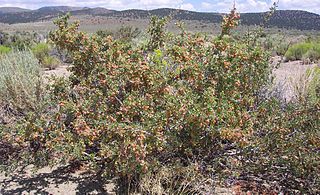
Prunus andersonii is a species of shrub in the rose family, part of the same genus as the peach, cherry, and almond. Its common names include desert peach and desert almond. It is native to eastern California and western Nevada, where it grows in forests and scrub in desert and mountains. It was named after Charles Lewis Anderson by Asa Gray.

Thunbergia alata, commonly called black-eyed Susan vine, is a herbaceous perennial climbing plant species in the family Acanthaceae. It is native to Eastern Africa, and has been naturalized in other parts of the world.
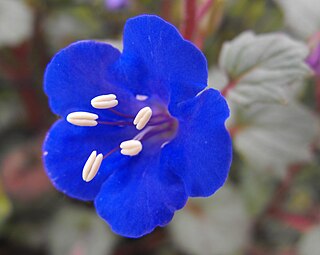
Phacelia campanularia is a species of flowering plant in the borage family, Boraginaceae, known by the common names desertbells, desert bluebells, California-bluebell, desert scorpionweed, and desert Canterbury bells. Its true native range is within the borders of California, in the Mojave and Sonoran Deserts, but it is commonly cultivated as an ornamental plant and it can be found growing elsewhere as an introduced species.
Phacelia adenophora is a species of phacelia known by the common name glandular yellow phacelia. It is native to the northwestern United States where it can be found in Oregon, northeastern California, and northwestern Nevada. It grows in mountain and plateau habitat. This is an annual herb producing decumbent, creeping, spreading, or upright branched stems up to 40 centimeters long. The leaves are oblong in shape and deeply lobed, measuring up to 3 centimeters long, and concentrated at the base. The inflorescence is a one-sided cyme of many bell-shaped flowers each under 1 cm long. The petals are fused at the base with five lobes. Unlike many phacelias, which bloom in shades of blue and purple, this species has yellow to golden flowers. It occasionally has purple edges on the corolla. It has five hairy stamens. The fruit is a fuzzy, oblong capsule a few millimeters in length containing up to 14 seeds.
Phacelia affinis is a species of flowering plant in the borage family, Boraginaceae, known by the common names limestone phacelia and purple-bell scorpionweed. It is native to the southwestern United States and Baja California and Sonora in Mexico. It can be found in scrub, woodland, forest, and other habitat.

Phacelia argentea is a rare species of phacelia known by the common names sand dune phacelia and silvery phacelia. It is native to the coastline of southwestern Oregon and far northwestern California, where it was counted at a total of 33 sites in 1995. It is the only phacelia species endemic to coastal sand dune habitat, an ecosystem which is altered and declining in the area.

Phacelia curvipes is a species of flowering plant in the borage family, Boraginaceae, known by the common names Washoe phacelia and Washoe scorpionweed. It is native to the southwestern United States, where it grows in many types of habitat, such as chaparral, oak and pine woodland, and forests.

Phacelia davidsonii is a species of phacelia known by the English name Davidson's phacelia named by Asa Gray for the discoverer of this annual plant, Anstruther Davidson, a Scottish naturalist who emigrated from Scotland to Los Angeles, California, in the late nineteenth century. This native forb occurs in southern California and southern Nevada, where it grows in mountains and foothills in chaparral and woodland habitats. In California, this herb is found in the Southern Sierra Nevada, Transverse Ranges, and Peninsular Ranges.
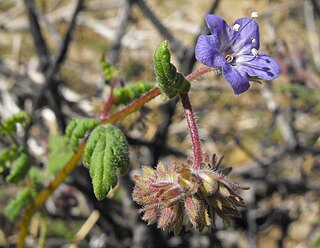
Phacelia distans is a species of flowering plant in the borage family, Boraginaceae, known by the common names distant phacelia and distant scorpionweed. It is native to the southwestern United States and northwestern Mexico, where it grows in many types of habitat, including forest, woodland, chaparral, grassland, and meadows.
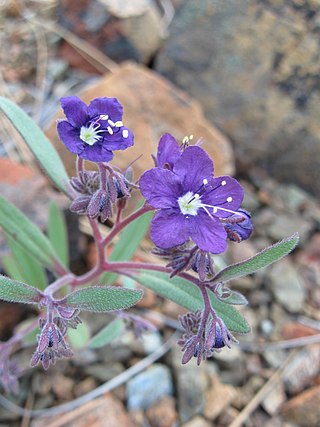
Phacelia greenei is a species of phacelia known by the common name Scott Valley phacelia. It is endemic to the southern Klamath Mountains of far northern California, where it is known only from Scott Valley, a valley known for its alfalfa growing, and vicinity.

Phacelia hastata is a species of flowering plant in the borage family, Boraginaceae. Its common names include silverleaf scorpionweed, silverleaf phacelia, and white-leaf phacelia. It is native to western North America from British Columbia and Alberta south to California and east to Nebraska. It can be found in many types of habitat, including scrub, woodland, and forest, up to an elevation of 13,000 feet. It prefers sandy to rocky soil.
Phacelia longipes is a species of phacelia known by the common name longstalk phacelia. It is endemic to California, where it grows in the Transverse Ranges and adjacent western Mojave Desert. Its habitat includes chaparral, woodland, and forest, in rocky soils.

Phacelia mutabilis is a species of flowering plant in the borage family known by the common name changeable phacelia. It is native to the western United States and Baja California, where it can be found in mountains and foothills, in forested and open habitat types, and deserts.

Phacelia nemoralis is a species of flowering plant in the borage family known by the common name shade phacelia. It is native to the west coast of the United States from Washington to central California, where it grows in moist, usually forested areas along the coastline and in the coastal mountain ranges.
Phacelia orogenes is an uncommon species of phacelia known by the common name mountain phacelia. It is endemic to California, where it is known only from the southern High Sierra, particularly around Mineral King in Sequoia National Forest.

Phacelia pringlei is a species of flowering plant in the borage family known by the common name Pringle's phacelia. It is endemic to far northern California, where it is known only from the southern Klamath Mountains. It grows in coniferous forest and open mountain slopes.
Phacelia stebbinsii is an uncommon species of phacelia known by the common name Stebbins' phacelia.

Phacelia tanacetifolia is a species of flowering plant in the borage family Boraginaceae, known by the common names lacy phacelia, blue tansy, purple tansy or fiddleneck (UK).
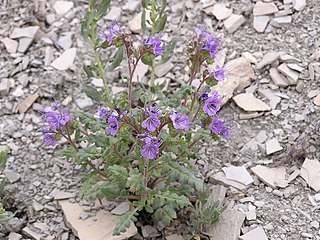
Phacelia argillacea is a rare species of flowering plant in the borage family known by the common names clay phacelia and Atwood's phacelia. It is endemic to Utah in the United States, where it is known only from one canyon in Utah County. It is "one of Utah's most endangered species"; it is "one of the nation's rarest plants" and is federally listed as an endangered species of the United States.















